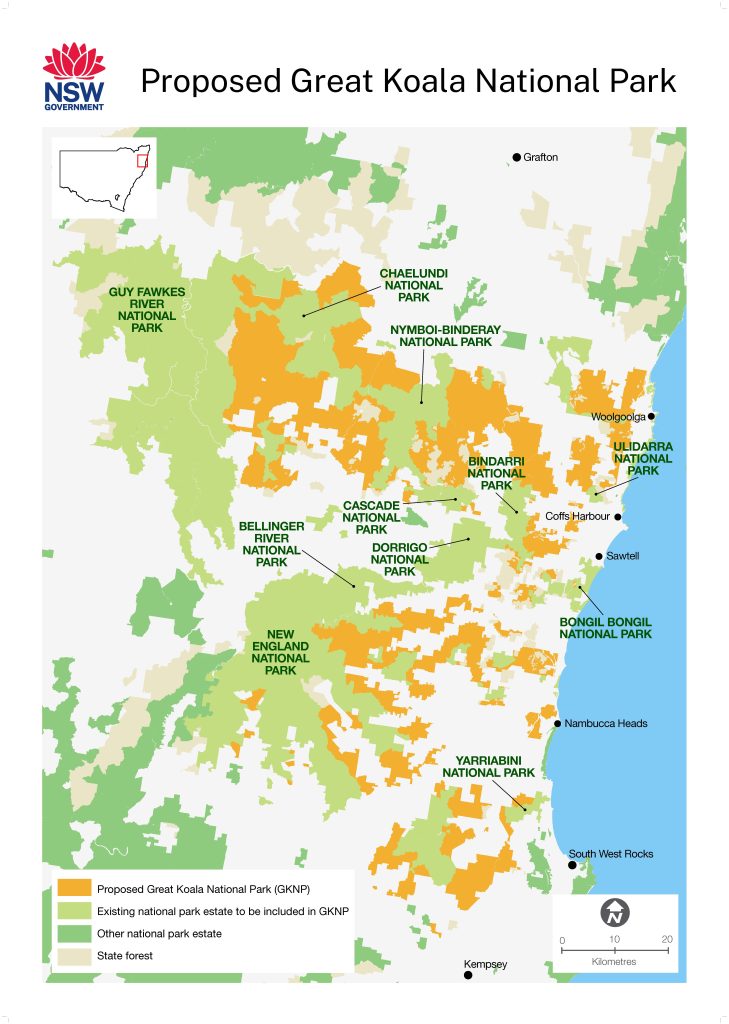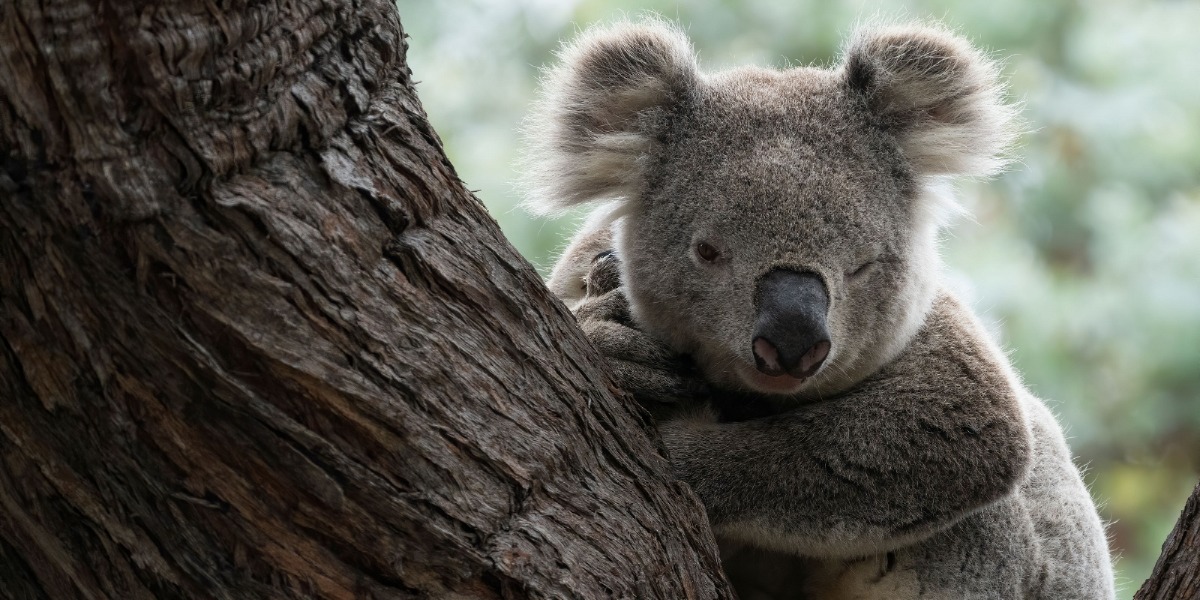After more than a decade of election promises, the Great Koala National Park (GKNP) has finally been announced by the NSW Government, but the arguments over culture, conservation and cost continue.
The proposed boundary will add 176,000 hectares of state forest to existing reserves, creating a 476,000-hectare network stretching from the escarpment to the coast. Logging within the proposed area has been suspended under a temporary moratorium, with the government pledging $60 million to establish the park and $6 million in small business and tourism support for the Mid North Coast.
“Koalas are at risk of extinction in the wild in NSW – that’s unthinkable,” said Premier Chris Minns.
“The Great Koala National Park is about turning that around.”
Koalas in New South Wales were declared endangered by the NSW Independent Scientific Committee and the Australian Government in 2022. Koala drone surveys conducted across the assessment area between April and July 2024 detected an estimated population of between 10,300 and 14,540 koalas, with a mean estimate of 12,111 koalas. The Great Koala National Park will provide large areas of connected and high-quality habitat to protect this significant koala population.

Environment Minister Penny Sharpe called the announcement the fulfilment of a long campaign.
“The Great Koala National Park has been a dream for more than a decade.”
“It will ensure koalas survive into the future so our grandchildren will still be able to see them in the wild.”
The government says the park will protect more than 12,000 koalas, 36,000 greater gliders and habitat for over 100 threatened species. Six of more than 25 regional timber mills and about 300 jobs will be directly affected.
Supporters praise the move as good for culture and conservation
An array of conservation groups celebrated the announcement, arguing the park is the scale required to give koalas a fighting chance.
“This is an incredible moment for Australia’s National Parks,” said NPA NSW President Liz Jeremy. “The culmination of more than a decade of determined advocacy for the future of koalas by local communities and conservationists.”
The areas selected for inclusion in the park incorporates traditional lands of the Gumbaynggirr and Dunghutti peoples, as well as a number of sensitive environmental sites.
For Gumbaynggirr custodians, the significance of keeping Dunggiirr (koala) on Country is cultural as well as ecological.
“We believe the GKNP is a positive opportunity to protect and preserve this cultural heritage within a precious biodiversity hotspot,” Gumbaynggirr man Michael Donovan told the parliamentary inquiry into establishing the park.
Dedicated Aboriginal rangers will be employed through Aboriginal community-controlled organisations to work on cultural heritage within the park.
Greens MP Sue Higginson welcomed the announcement but attacked the delay.
“We are jubilant that 176,000 hectares of our public native forests on the Mid North Coast are finally off the logging schedule. This victory belongs to the communities, First Nations leaders, scientists and forest defenders who never gave up,” she said.
“The Government’s justification for the two and a half year wait is a shock to the system, to say they were unsure about job numbers feels like a kick in the face.”
However, some say the battle to save the species is far from over. The Australian Conservation Foundation said 2025 is already the worst year on record for federally approved destruction of koala habitat, with almost 4,000 hectares cleared so far.
Timber towns fear the worst
The reaction from the timber industry was swift, with the Australian Workers’ Union and the Timber, Furnishing & Textiles Union among those who condemned the announcement.
“Minister Sharpe has chosen to ignore the government’s own expert panel’s advice and to bow to an irrational, deep green ideological agenda that will gut regional towns on the NSW mid north coast,” said AWU NSW Secretary Tony Callinan.
“Every timber worker’s pay cheque flows directly into small regional economies. When you kill the timber industry, you kill the towns,” TFTU NSW Secretary Alison Rudman said.
“Businesses close, schools lose students, health services withdraw, and entire communities wither away.”
The Unions point to the government’s own Industry Advisory Panel, which recommended 37,000 hectares as a compromise. Instead, the footprint is nearly five times larger.
“Timber workers in the region earn, on average, twice as much as those in tourism. No family can absorb a 50% pay cut in the middle of a cost-of-living crisis,” Ms Rudman said.
Forest & Wood Communities Australia estimates the cost to NSW could exceed $1.25 billion.
“The industry respects the Government’s election promise to create the GKNP, but the second part of their election promise was do so in a manner that maintained a viable, sustainable timber industry,” FWCA Executive Officer Steve Dobbyns said.
“We know the science shows koalas are unaffected by our highly regulated, sustainably managed timber harvesting operations and by which side of the National Park/State forest boundary they live on, so we provided Government with various options so they could fulfil both election commitments.
“It’s unfortunate that they have ignored that advice and taken the worst case scenario, which will likely cost NSW upwards of $1.25 billion”, said Mr Dobbyns.
Barnaby Joyce also weighed in during a visit to the tiny community of Lower Creek, in a very remote corner of Australia in the hills and gorges between Armidale and Kempsey, which he says is threatened by the planned park.
“With timber and cattle as their main industries, they have been told they are going to be part of a new massive koala park as if they had been hunters of koalas for the last couple of hundred years,” he said.
“You couldn’t make this stuff up! The virtue chasing, mindless bureaucracy of government in Sydney trying to tick a box of some grand environmental plan without any thought to the problems and hurt they will cause.”
“This is not a wealthy district, it is a resilient and tough district, and those who have wealthy and comfortable lives, surrounded by all the social capital that the inner suburbs of the capital city can provide, have decided that koalas come before people, as long as it’s not people in their suburb in Sydney.
Joyce has been on record opposing protection of koalas in NSW for many years, dismissing reports that koalas may become extinct by 2050 as “rubbish”.
Opportunities and support for the deal not yet finalised
The moratorium on logging in the new park areas came into effect on Monday 8 September. However, the park’s legal creation depends on the successful registration of a carbon project under the Federal Government’s Improved Native Forest Management Method.
Minister for the North Coast and Minister for Small Business, Janelle Saffin, said they were committed to supporting communities through the transition but they should also see the opportunity.
“This will deliver the protection of our most precious and loved species, our koalas, that everyone in NSW wants to see protected; and the Greater Koala National Park will also provide an economic boon for locals and businesses alike.”
Local businesses also see the opportunity.
“The businesses are supportive of the Great Koala National Park,” Bellingen Chamber president Frank J Perez said.
“The value our area ecosystem and ecotourism generates is immense.”
The government insists support will match the scale of the change. Workers will be offered JobKeeper-style payments to cover salaries, while businesses will receive help with operating costs. Families will have access to free financial, legal and mental health counselling, alongside training support.
Forestry Corporation staff are expected to be offered transfers into National Parks and Wildlife Service roles if they choose.
“We’ve listened carefully and we’re making sure workers, businesses and communities are supported every step of the way,” Premier Minns said.
Read all the way through to the end of the story? So did lots of other people. Advertise with New England Times to reach New England locals who are interested and engaged. Find out more here.

